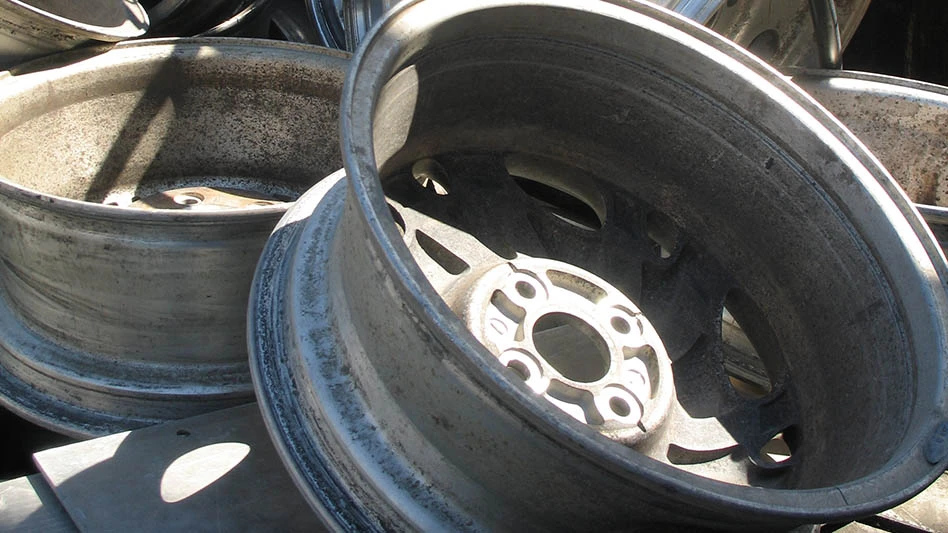
Chicago-based General Iron Industries Inc. has invested $2 million to install a regenerative thermal oxidizer (RTO) on its mega shredder. The RTO is designed to reduce emissions of volatile organic compounds (VOCs) from the company’s auto shredder, which has been operating at the site since 2002.
Catalytic Products International (CPI) of Lake Zurich, Illinois, supplied the RTO, which was installed last summer. Since the installation was completed in July, General Iron and the Illinois Environmental Protection Agency (EPA) have agreed on an administrative consent order resolving the alleged violations the EPA issued in 2018.
Adam Labkon, vice president of General Iron, describes the installation of the RTO as a “proactive step.”
A proactive response
In late 2017, the EPA requested air emissions testing for General Iron’s auto shredder. The company says it conducted emissions testing for total VOCs, particulate matter (PM) and metals May 24 and May 25, 2018, and for metals again June 13 and June 14, 2018.
According to an Aug. 23, 2018, letter from General Iron attorney Ann M. Zwick of the law firm Freeborn & Peters LLP, Chicago, to Erik Olson, U.S. EPA associate regional counsel, “We believe that the results of the independent emissions testing demonstrate that no emissions of metals or filterable PM violated any permitted levels of applicable requirements. General Iron is one of only a few metal shredding facilities, and the only one in the Chicago area, that has installed a high-efficiency air filter to control PM and metals emissions, and the test results support the filter’s effectiveness. The PM and metals testing required by EPA, including for 17 specific metals, as well as the additional impact assessment that General Iron voluntarily performed, demonstrate that General Iron’s PM and metals emissions were far below relevant limits.”
The letter also states that “General Iron acknowledges that the emissions testing showed that its potential to emit VOCs exceeds the Title V major source threshold.” However, it adds, “It is important to note that (1) actual VOC emissions from the shredder over the past five years were less than 89 tons per year, which is below the current major source threshold of 100 tons per year and (2) General Iron has never operated anywhere close to its permitted levels. With the installation of the RTO, General Iron’s potential VOC emissions will be significantly below the Title V major source threshold and will qualify General Iron for a FESOP (federally enforceable state operating permit).”
In absolute terms, General Iron says its VOC emissions are a fraction of the overall VOC emissions from stationary sources in Cook County, Illinois. The company says its actual VOC emissions from the shredder, averaged annually over five years, were about 0.17 percent of the VOC emissions from all stationary sources across Cook County in 2014, based on Illinois EPA data submitted to the U.S. EPA’s National Emissions Inventory.

However, Labkon says the testing showed the company’s “potential to emit” could exceed permitted requirements. He adds that General Iron does not run the shredder 24 hours per day, seven days per week, but for one shift daily, which can range from 11-to-12 hours with on-and-off operation, from five to seven days per week.
A recent agreement between the company and the city to relocate General Iron’s existing location on Chicago’s north side to its new owner Reserve Management Group’s (RMG’s) existing location on the south side also imposes oversight of its activities, including limiting the shredder to operating between 7 a.m. and 9 p.m.
The consent order that General Iron reached with the EPA memorializes the RTO’s installation and operation and sets a timetable for demonstrating its efficiency and obtaining the proper permit, which fully resolves the notice that the EPA issued in July 2018, the company says.
Operating requirements
General Iron runs an 8,300-horsepower auto shredder from Riverside Engineering, San Antonio. Labkon says the shredder processes a mixture of auto hulks and structural steel from demolition sites and light iron and miscellaneous steel, with the latter combination making up the bulk of the company’s feedstock.
Under the EPA consent order, General Iron must ensure the RTO destroys 98 percent of the shredder’s VOC emissions. The company tested the effectiveness of the unit in late November 2019.
General Iron says it conducted this performance testing under the supervision of the U.S. EPA. The preliminary test results, which the company says will become public when finalized, demonstrate that General Iron’s RTO meets a minimum destruction efficiency of at least 98 percent.
“This means that General Iron is outperforming a state regulation designed to help bring the region into attainment with the National Ambient Air Quality Standard (NAAQS) for ozone by reducing shredder VOC emissions well in excess of the required 81 percent,” the company said in a statement issued Dec. 3, 2019, in response to what it says are “recent inquiries from neighbors … [and] the substantial misinformation that is being spread about us in the neighborhood.”
Within three months of completing the performance testing, General Iron says it will apply to the Illinois EPA, incorporating operating, monitoring and record-keeping requirements for the RTO into a FESOP.
How the technology works
Jim Kallas, General Iron’s environmental manager, says General Iron selected CPI to supply the RTO because, as a local company, General Iron thought CPI would provide good service. “We looked at three companies before choosing them.”
Stephen H. Klostermeyer, vice president of sales and marketing for CPI, says that while the company has received only a few specific inquiries from shredder operators, air emissions controls are a growing area of concern for the industry. “They are on the radar of most everyone that I have spoken to in the industry.”
When it comes to controlling auto shredder emissions, he says, “It starts with emissions containment and collection. In some cases, the shredder operator may only need to add particulate control. However, if the level of VOC emissions exceeds the regulations, they may have to implement VOC control, as well.”
Klostermeyer adds that companies like Buffalo, New York-based Wendt Corp., a supplier of auto shredders and downstream sorting systems, are focused on providing solutions for the containment and collection of emissions as well as large and small particulate control, while CPI is focused on VOC, acid gas and compliant air discharge. While he says it can be more common for shredder operators to control particulate emissions from their machines using a cyclone, controlling VOCs using an RTO is a new focus.

For an RTO to work effectively, however, shredder operators also should install particulate control so that the RTO does not get plugged up, Scott Harmsen, chief operating officer of CPI, says.
General Iron installed a high-efficiency air filter, consisting of a capture hood, cyclone and roll-media filter system, in 2013 to control PM and metals emissions.
The RTO destroys VOCs by heating the shredder exhaust gases at extremely high temperatures. The hot RTO exhaust gases then pass through a quench/packed tower scrubber, evaporating a portion of the scrubber water and generating steam.
RTOs offer cost savings over other thermal oxidizers because of the regenerative nature of the heat exchanger design, CPI says. The unit heats the inlet gases as they enter the ceramic-media-filled regenerator column to a temperature in excess of 1,425 F upon exit of the ceramic media. The preheated gases then enter the combustion chamber and are heated to the temperature at which oxidation of the VOCs occurs, which is generally 1,500 F. The air then passes through the second heat exchanger, which also has ceramic filter media, and is cooled before being directed to the exhaust stack and released into the atmosphere. The exchange of air from the second regenerator column with the first is why RTOs have a thermal efficiency in excess of 95 percent, CPI adds.
The VOCs are oxidized, or combined chemically with oxygen, in the RTO and turned into CO2 and water that are emitted to the atmosphere, Harmsen says.
Klostermeyer says he recommends that shredder operators seek input from air pollution control consultants who understand local regulations before shopping for emissions control products.
Foundations for the future
General Iron RMG, which has headquarters in Stow, Ohio, and Chicago, agreed in July 2019 to relocate the General Iron facility to Chicago’s south side.
This facility will feature a European-style enclosed shredder on a 175-acre site that is approximately seven times larger than General Iron’s current location. The partners say they will invest $65 million to $70 million in the new facility. In addition, the RTO will be transferred from the company’s existing site to the new site, Labkon says, and put into operation there.
General Iron reached an agreement with the administration of Chicago Mayor Lori Lightfoot, Alderman Brian Hopkins and Alderman Susan Sadlowski Garza that lays out additional operating requirements for the company until it moves.
“We are grateful for the mayor and her team’s leadership in forging an appropriate compromise to support the continuity of the critical service that General Iron has performed for more than a century,” Labkon says. “We are excited that this new venture, led by RMG, will continue providing more than 100 jobs and critical metal recycling services.”
“We appreciate the city’s assistance in helping us to move forward with building a new, state-of-the-art facility to complement RMG’s existing recycling operations on the city’s south side,” says Steve Joseph, president of RMG. “We expect to create nearly 800 on- and off-site construction jobs, and we are committed to protecting the environment and public health and safety as the business transitions from the north side to our longtime south-side home.”

Explore the January 2020 Scrap Metals Supplement Issue
Check out more from this issue and find your next story to read.
Latest from Recycling Today
- RMDAS April figures show recycled steel price setback
- Steer World offers PEX plastic recycling machine
- New recycling grant program launches in Massachusetts
- Tire Recycling Foundation names executive director
- Dock 7 named 2025 Exporter of the Year at New Jersey International Trade Awards
- Waste Connections reports ‘better than expected’ Q1 results
- Commentary: How EPR is transforming the packaging industry
- Acerinox names new North American Stainless CEO





